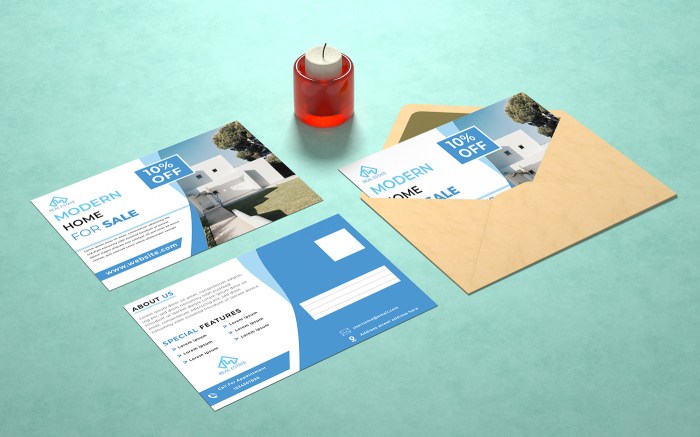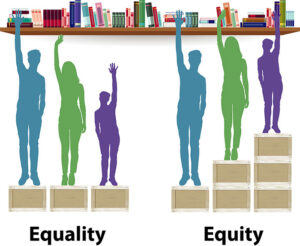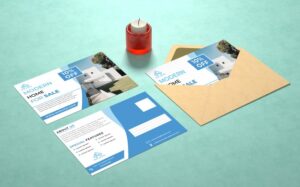
Postcard marketing design is a powerful tool for engaging customers and promoting businesses effectively. By combining striking visuals with compelling messaging, postcards can capture attention in ways that digital marketing sometimes cannot.
This approach not only enhances brand visibility but also fosters personal connections with the target audience. In a world overflowing with digital distractions, a well-designed postcard can stand out and encourage meaningful customer interactions.
Understanding Postcard Marketing Design
Postcard marketing design plays a crucial role in promotional campaigns, acting as a bridge between businesses and their customers. A well-crafted postcard can capture attention, convey messages succinctly, and prompt action, making it an indispensable tool in any marketer’s arsenal. Effective postcard design is characterized by several fundamental elements, including eye-catching visuals, clear messaging, and a compelling call to action.
The use of appropriate colors and typography can enhance readability and engagement, while images can evoke emotions and create memorable impressions. Ultimately, the design of a postcard can significantly influence customer engagement and response rates, leading to successful marketing outcomes.
Creative Design Techniques
Modern postcard marketing employs various innovative design techniques that elevate its appeal. Key among these are the use of vibrant color schemes and unique typography that resonate with the target audience.
Color Schemes
Utilizing contrasting colors can draw attention and enhance visual interest. For instance, a combination of bold reds and calming blues can create an attractive visual hierarchy that guides the viewer’s eye.
Typography
Choosing the right font can communicate the brand’s personality. A playful font may suit a casual café, while a sleek, modern typeface may be more fitting for a high-end retailer.The impact of visuals and imagery cannot be overstated. Striking images can tell a story at a glance, making them integral to postcard design. For instance, a postcard promoting a beach resort might feature a stunning sunset over the ocean, instantly evoking feelings of relaxation and desire.
Target Audience Considerations
Identifying and understanding the target audience is essential for effective postcard marketing. This involves analyzing demographic data and preferences to tailor designs that resonate with specific groups. To customize postcard designs effectively, businesses can employ methods such as:
Surveys and Feedback
Gathering insights directly from customers can reveal their preferences and interests.
Market Research
Analyzing market trends and competitor strategies can provide valuable information about what appeals to the target demographic.Segmenting audiences allows for more personalized messaging, improving the effectiveness of postcard campaigns. For example, postcards tailored for families may highlight kid-friendly promotions, while those targeting young professionals could focus on nightlife or events.
Integration with Business Innovation
Innovative design plays a pivotal role in postcard marketing, allowing businesses to stand out in a saturated market. Integrating postcard marketing with new technologies can enhance its effectiveness. For example, augmented reality (AR) can be used to bring postcards to life, offering interactive experiences that engage customers in ways traditional postcards cannot. Brands like IKEA have successfully incorporated AR into their marketing strategies, allowing customers to visualize products in their own space through postcards.Current trends in postcard design reflect broader business innovations, such as the use of eco-friendly materials and sustainable printing practices, catering to environmentally conscious consumers.
Postcard Marketing for International Business
Designing postcards for international markets presents both challenges and opportunities. Understanding cultural differences is vital to ensure the message and visuals are appropriate and resonate with local audiences. Cultural considerations can include:
Imagery
Certain symbols or colors may have different meanings across cultures. For example, while white is associated with purity in some societies, it can signify mourning in others.
Language
Localization of content is crucial for ensuring clarity and relatability. Simple, clear language can bridge language barriers effectively.Best practices for localization include hiring local designers who understand the cultural nuances and preferences of the target market. This approach can lead to more impactful and relatable postcard designs.
Effective Messaging Techniques
Crafting compelling messages is a fundamental aspect of postcard marketing. Messages should be concise, engaging, and aligned with the overall marketing strategy. Balancing visuals and text is essential for maximum impact. A postcard should not be overcrowded with information; instead, it should highlight key messages while allowing visuals to complement the text. Effective call-to-action strategies can drive customer response significantly.
Phrases like “Visit us today for exclusive offers!” or “Scan the QR code for a surprise discount!” create urgency and encourage immediate action.
Budgeting for Postcard Marketing Design

Understanding the costs associated with postcard design and printing is vital for creating a successful marketing strategy. Factors influencing costs include design complexity, paper quality, and printing techniques. To create a cost-effective postcard marketing strategy, businesses can:
- Utilize in-house design teams to reduce costs.
- Choose economical printing options without sacrificing quality.
- Take advantage of bulk printing discounts.
The return on investment (ROI) associated with postcard marketing can be significant, especially when campaigns are well-targeted and designed. Tracking response rates and analyzing customer feedback can help businesses refine their strategies for better results.
Business Networking Applications
Postcard marketing can enhance business networking efforts by serving as a tangible reminder of connections made. Following up with postcards after networking events can strengthen relationships and encourage future interactions. Methods for using postcards in follow-up communications include:
- Sending personalized messages thanking contacts for their time.
- Highlighting shared interests or future meeting opportunities.
Successful networking stories often feature businesses that have effectively used postcards to maintain relationships, such as sending updates or special offers to previous contacts.
Postcard Marketing in the Restaurant Industry
In the restaurant sector, specific design elements can attract customers and encourage visits. Bright colors, appetizing food images, and enticing offers can create a strong appeal. Strategies for using postcards to promote special events and menu items include:
- Highlighting seasonal promotions or limited-time offers.
- Featuring customer testimonials or reviews to build trust.
Examples of successful postcard campaigns from restaurants include those that showcase signature dishes, enticing potential diners with vibrant imagery and compelling copy.
Measuring Success and Productivity

Measuring the success of postcard marketing campaigns involves identifying key metrics. This can include response rates, conversion rates, and overall sales generated from the campaign. Tools and techniques for tracking customer response rates can include:
- Unique promo codes included in the postcards.
- Call tracking numbers dedicated to postcard inquiries.
Analyzing campaign performance helps businesses understand what worked and what didn’t, allowing for continuous improvement in future postcard designs.
Risk Management in Postcard Marketing
Postcard marketing campaigns come with potential risks that need to be managed. Common risks include design errors, mis-targeted audiences, and poor distribution strategies. Strategies for mitigating these risks include:
- Implementing thorough review processes before printing.
- Utilizing data analytics to ensure targeted distribution.
Adapting postcard marketing strategies in response to unexpected challenges involves being flexible and responsive to market changes, ensuring continued effectiveness.
Team Collaboration in Design Process
The postcard design process benefits from collaboration across various team members, including designers, marketers, and copywriters. Each member plays a crucial role in ensuring the final product is cohesive and aligned with brand messaging. Techniques for fostering collaboration include:
- Regular brainstorming sessions to generate ideas.
- Utilizing project management tools that allow team members to communicate and share feedback easily.
Feedback loops are essential in improving postcard design efficiency, ensuring that all perspectives are considered and incorporated.
Strategic Planning for Campaigns
Strategic planning is vital in postcard marketing to ensure campaigns are aligned with broader business objectives. A well-defined framework can guide the development of effective strategies. Elements of a successful postcard marketing strategy include:
- Setting clear goals and objectives.
- Identifying target audiences and tailoring messages accordingly.
Aligning postcard campaigns with overall business objectives ensures that marketing efforts contribute to long-term success and growth.
Sales Management and Postcard Marketing
Integrating postcard marketing within sales strategies can enhance outreach efforts. Postcards can serve as effective tools for engaging prospects and nurturing leads. For instance, sending postcards with special offers or reminders about upcoming events can support sales teams in their efforts. Measuring the impact of postcards on sales performance involves tracking sales generated from postcard responses and analyzing the effectiveness of different designs and messages.
Workplace Communication and Design Feedback
Workplace communication plays a significant role in the postcard design process. Clear communication among team members ensures that everyone is aligned on goals and messaging. Techniques for giving and receiving feedback include:
- Establishing guidelines for constructive criticism.
- Creating a culture of openness where team members feel comfortable sharing their thoughts.
An open environment for design critiques fosters collaboration and innovation, ultimately leading to better postcard outcomes.
Summary
In conclusion, postcard marketing design represents an intersection of creativity and strategy, allowing businesses to craft memorable messages that resonate with their audience. By leveraging effective design techniques and understanding target demographics, companies can achieve remarkable results in their marketing campaigns.
Question & Answer Hub
What are the benefits of postcard marketing?
Postcard marketing offers high visibility, cost-effectiveness, and a personal touch that can enhance customer relationships.
How can I measure the success of my postcard campaign?
Success can be measured through response rates, customer engagement metrics, and tracking sales that result from the campaign.
What are some common design mistakes to avoid?
Avoid cluttered designs, poor-quality images, and unclear messaging, as these can detract from the postcard’s effectiveness.
How often should I send postcards to my audience?
Frequency can vary based on your audience and goals, but regular intervals, such as quarterly or bi-monthly, can maintain engagement without overwhelming recipients.
Can postcards be used for online businesses?
Absolutely! Postcards can complement online marketing efforts by driving traffic to websites and promoting special online offers.





